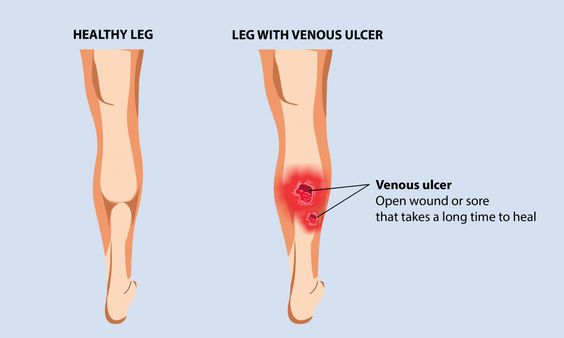Vascular ulcers are skin wounds that develop due to abnormal blood circulation in the body. While ulcers can occur anywhere on the body, venous and arterial ulcers are the two most common forms. Clinical nurses also need to distinguish these two types of ulcers and give more targeted treatment plans. Let's take a look with me below.
What is a venous arterial ulcer?
Venous ulcers: Usually occur on the lower parts of the legs and ankles. This condition is usually caused by a problem with a deep vein, such as a deep vein thrombosis or valve insufficiency. This results in a constant blockage of blood in the lower leg, causing a long-term buildup of venous waste and toxins in the area. These wastes and toxins will remain in the surrounding tissues and be mixed in the congested interstitial fluid, causing swelling, dehydration, softening of the skin, and finally the formation of venous ulcers.
Arterial Ulcers: Usually occur in the toes, feet, ankles, and around the ankles. This condition is usually due to a narrowed or blocked blood vessel that prevents surrounding tissues from getting enough oxygen and nutrients. In the feet, it is usually due to peripheral arterial disease. Over time, the loss and death of surrounding tissue eventually cause ulcers to form in the area.
Arterial and venous ulcers are two different types of ulcers with different risks and hazards.
The risks of arterial ulcers include:
Concomitant risks of cardiovascular disease, such as heart attack and stroke.
Tissue necrosis and infection may result because blood flow is reduced.
If left untreated, it can lead to amputation.
The risks of venous ulcers include:
Risk of developing blood clots, which can lead to thromboembolism and cause other disorders.
May cause bacterial infections and other diseases.
May cause chronic ulcers and risk of long-term treatment.
Proper treatment and preventive measures can reduce these risks. If you think you have an ulcer, please consult a professional doctor in time for treatment.
How do they differ in treatment?
Arterial and venous ulcers are two different types of skin ulcers. Arterial ulcers usually occur in the foot or ankle and are caused by the insufficient arterial blood supply. Venous ulcers usually appear in the legs above the ankle and are caused by poor circulation in the veins.
1. The method of treating venous ulcers includes:
1. Compression therapy to increase venous return by using medical bandage first aid.
2. Drug therapy, such as rifampicin, macrolides, etc.
3. Surgical treatment, such as placement of stents, intravenous catheters, etc.
4. Local care, such as keeping the ulcer dry and clean, using drugs, etc.
2. Methods for treating arterial ulcers include:
1. Keep feet and ankles clean and dry to avoid infection.
2. The use of drug treatment, such as antibiotics, painkillers, and so on.
3. Surgically remove necrotic tissue, improve blood circulation, and accelerate healing.
4. Change lifestyle and eating habits, such as smoking cessation, balanced diet, etc.
Finally, it should be noted that both venous and arterial ulcers also share some symptoms, such as pain and discomfort. So if you suspect you may have one of these ulcers, see your doctor for diagnosis and treatment. This will help keep the ulcer from getting worse and improve the chances of healing.
For more information on Innomed® Medical Bandage First Aid, refer to the previous articles. If you have customized needs, you are welcome to contact us; we will serve you wholeheartedly.
At Longterm Medical, we transform this data by innovating and developing products that make life easier for those who need loving care.
Editor: kiki Jia
Date: March 16, 2023

 English
English عربى
عربى Español
Español русский
русский 中文简体
中文简体








